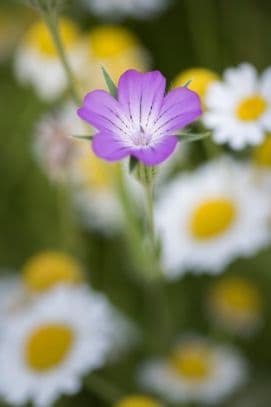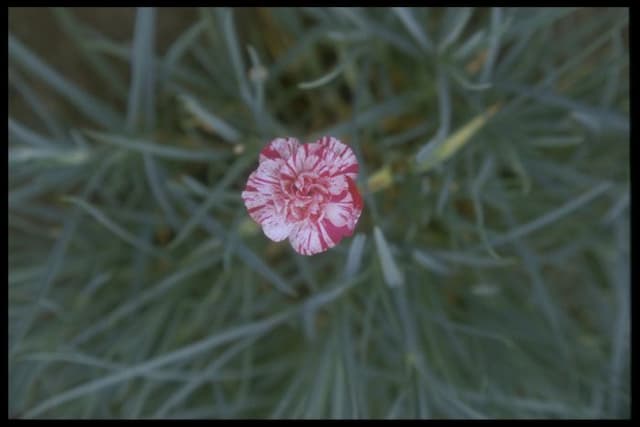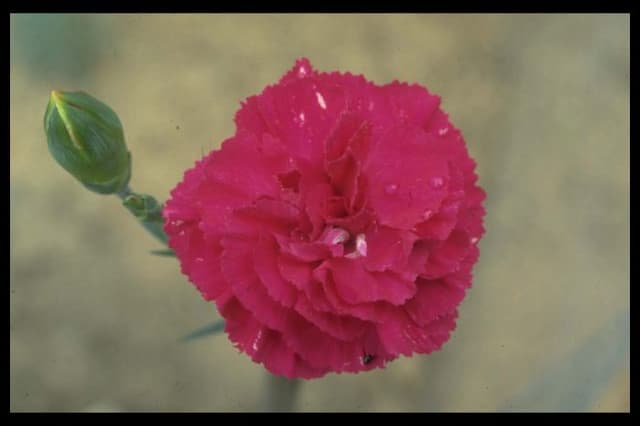Carnation Dianthus 'Michael Saunders' (b)

ABOUT
Dianthus 'Michael Saunders', commonly known as a variety of carnation or pink, is a beautifully ornamental plant that showcases an exquisite array of blossoms. The flowers are notably characterized by a warm and vibrant hue, often presenting in shades of pink, red, or sometimes a mix of both. They are also known for their frilly or serrated petal edges which add a touch of delicacy and intricate detail to their overall appearance. The petals might also display varying color patterns or markings, further enhancing their visual appeal. The plant itself maintains a compact and tidy form, with narrow, needle-like leaves that are typically green to blue-green in color. These leaves can sometimes have a grayish cast, adding to the plant's allure. The foliage presents a dense and bushy appearance, serving as the perfect backdrop to the radiant flowers that perch atop slender, yet sturdy stems. These flowers typically emit a subtle and sweet fragrance, a characteristic feature that adds to the sensory pleasure of the plant. The blooms appear to have a textured surface, often being described as velvety or slightly ruffled which captures and plays with the light, creating a lovely shimmering effect. With its beautiful flowers and fragrance, Dianthus 'Michael Saunders' is certainly a charming addition for anyone looking to add a splash of color and fragrance to their garden or floral arrangements.
About this plant
 Names
NamesFamily
Caryophyllaceae
Synonyms
Sweet William, Garden Pink, Carnation
Common names
Dianthus 'Michael Saunders'
 Toxicity
ToxicityTo humans
The Dianthus 'Michael Saunders', commonly known as Carnation, is not typically considered toxic to humans. However, ingestion of any plant material can sometimes cause gastrointestinal discomfort such as nausea, vomiting, or diarrhea in sensitive individuals. It is always recommended to avoid eating ornamental plants due to potential individual reactions.
To pets
Carnation, the common name for Dianthus 'Michael Saunders', is generally recognized as non-toxic to pets, including cats and dogs. Ingesting parts of this plant is unlikely to cause serious harm, but as with any non-food item, consumption could potentially lead to mild gastrointestinal upset in some pets. Signs might include vomiting or diarrhea, though this is not common. If a pet ingests a large amount of the plant and shows adverse symptoms, it is advisable to contact a veterinarian.
 Characteristics
CharacteristicsLife cycle
Perennials
Foliage type
Evergreen
Color of leaves
Green
Flower color
Pink
Height
1 foot 12 inches (30 cm)
Spread
1 foot 12 inches (30 cm)
Plant type
Herb
Hardiness zones
5
Native area
Europe
Benefits
 General Benefits
General Benefits- Attractive Blooms: Carnations are popular for their colorful and often fragrant flowers which can enhance the beauty of any garden or floral arrangement.
- Long Blooming Season: Carnations typically have a long blooming period, offering color and interest for an extended time.
- Low Maintenance: Carnations are known for being hardy and relatively easy to care for, which makes them suitable for many gardeners with varied levels of experience.
- Drought Tolerance: Once established, carnations are quite drought-tolerant, reducing the need for frequent watering.
- Versatile Use: Carnations can be used in various settings including borders, rock gardens, containers, and as cut flowers in bouquets.
- Cold Hardy: They are generally cold-hardy and can survive in cooler climates, returning each year if perennial varieties are planted.
- Pest Resistant: Carnations are often resistant to many common garden pests, making them a robust choice for the garden.
- Range of Colors: Carnations come in a wide range of colors, allowing gardeners to choose shades that best fit their landscape design.
- Edible Flowers: The petals of some carnation varieties are edible and can be used for culinary purposes, such as decorating cakes or as a garnish.
 Medical Properties
Medical PropertiesThis plant is not used for medical purposes.
 Air-purifying Qualities
Air-purifying QualitiesThis plant is not specifically known for air purifying qualities.
 Other Uses
Other Uses- Carnation petals can be crystallized with egg whites and sugar for decorative and edible purposes, often used to accent desserts or as a delicate candy.
- Their bright and attractive colors make carnations a popular choice for pressed flower crafts, providing long-lasting natural art material.
- Because of their layered structure, carnation petals can serve as natural dyes, adding color to homemade fabrics or crafts.
- Carnations are used in bath bombs and soaps for their fragrance and as natural decorations, enhancing the bathing experience.
- Dried carnation flowers offer an organic alternative to potpourri, infusing rooms with a mild spice-like scent without synthetic chemicals.
- Their long-lasting blooms make carnations suitable for fabric design, where the petals are used to create patterns on textiles.
- As a biodegradable confetti alternative, dried carnation petals can add a splash of color to weddings or celebrations with less environmental impact.
- Carnations are incorporated into homemade natural inks, creating unique colors for calligraphy or art projects.
- The flowers can be used to flavor drinks such as herbal teas or cocktails, offering subtle nuances to beverages.
- Carnation essential oil, distilled from the flowers, is used in aromatherapy to create soothing, stress-relieving environments.
Interesting Facts
 Feng Shui
Feng ShuiThe Carnation is not used in Feng Shui practice.
 Zodiac Sign Compitability
Zodiac Sign CompitabilityThe Carnation is not used in astrology practice.
 Plant Symbolism
Plant Symbolism- Love: Dianthus, commonly known as "Carnations" or "Pinks", often symbolize love and fascination. The connection to love makes them a popular choice for romantic occasions.
- Admiration: The flower conveys admiration and deep affection for someone. Their vibrant colors and pleasant fragrance express feelings of esteem.
- Distinction: Carnations are known to represent pride and beauty, highlighting the unique qualities and distinctiveness of an individual.
- Divine Love: In Christian symbolism, carnations are believed to have first appeared on Earth as Jesus carried the Cross, representing divine love and sacrifice.
 Water
WaterCarnations require even moisture and well-drained soil to thrive. It's best to water the plant deeply whenever the top inch of soil feels dry, which could be about once a week, depending on weather conditions. Aim to provide the equivalent of 1 inch of rainfall, which translates to about half a gallon for a standard-sized plant. Over-watering can be as detrimental as under-watering, so ensure the soil isn't waterlogged. During hotter, dryer periods, watering frequency may increase, but always check soil moisture before adding water.
 Light
LightCarnations flourish in full sunlight, which means the plant should receive at least six hours of direct sunlight daily. The best spot for these flowers is a southern or western-facing location that receives ample bright light. They can tolerate partial shade, but too much can result in weaker stems and fewer blossoms, so aim for a place with optimal sun exposure.
 Temperature
TemperatureCarnations prefer a temperate climate with temperatures ranging generally between 60°F and 70°F. They can withstand cooler nighttime temperatures down to about 40°F and upper daytime temperatures up to about 80°F. The plant can survive brief periods of colder or warmer weather but prolonged exposure outside of its ideal temperature range can stress the plant, potentially leading to poor growth and flowering.
 Pruning
PruningCarnations require pruning to promote bushy growth and abundant blooms. Deadhead spent flowers regularly to encourage more blooms and prune back by one-third in late summer to rejuvenate the plant. The best time to prune is after the main flowering flush but before the onset of winter; this helps maintain plant health and prepares it for the next growing season.
 Cleaning
CleaningAs needed
 Soil
SoilThe best soil mix for Carnations (Dianthus 'Michael Saunders') is well-draining and fertile, with a mix of loam, sand or grit, and compost or well-rotted manure to add nutrients. The ideal pH for Carnations is slightly alkaline, around 6.7 to 7.3.
 Repotting
RepottingCarnations, like Dianthus 'Michael Saunders', generally don't need frequent repotting and can be done every 2-3 years or when they outgrow their current pot, ideally in the spring.
 Humidity & Misting
Humidity & MistingCarnations (Dianthus 'Michael Saunders') prefer moderate humidity conditions; they do well with natural, ambient outdoor humidity but do not require extra indoor humidity.
 Suitable locations
Suitable locationsIndoor
Provide full sun, well-draining soil and water when top soil feels dry.
Outdoor
Plant in full sun, well-draining soil, water moderately, deadhead spent blooms.
Hardiness zone
3-9 USDA
 Life cycle
Life cycleDianthus 'Michael Saunders', commonly known as Pinks, begins its life cycle as a seed, which when sown in warm, well-draining soil and given proper care, germinates within one to two weeks. Seedlings emerge and grow vegetatively, developing a rosette of blue-green, grass-like leaves; during this stage, maintaining consistent moisture and avoiding waterlogged soil is crucial for healthy growth. As the plants mature, they enter the flowering stage, which typically occurs in late spring to early summer, showcasing fragrant, ruffled flowers in shades of pink, red, or white. After pollination, usually by bees or butterflies, the flowers will produce seed pods, containing seeds that can be collected for propagation or left to self-sow, hence continuing the life cycle. During the winter or off-season, the plant may enter a period of dormancy, where growth slows down but the plant remains alive, drawing from energy reserves in its perennial roots. In subsequent growing seasons, the plant will resume growth from the same root system, producing new shoots and flowers annually, for several years given proper care and climate.
 Propogation
PropogationPropogation time
Spring-Early Summer
The most popular method of propagating the Dianthus 'Michael Saunders', also known as pinks or carnations, is through softwood cuttings. Softwood cuttings are best taken in late spring to early summer when the plant's new growth is just hardening but not yet fully mature. To propagate, you would cut a 3- to 5-inch (8 to 13 cm) length of stem just below a node, strip the lower leaves, and dip the cut end into a rooting hormone. The cutting should then be inserted into a moistened mix of half perlite and half peat, ensuring good contact between the stem and the medium. The container can be covered with a plastic bag or placed in a propagator to retain humidity and placed in indirect light; rooting typically occurs within a few weeks, after which the new plants can be acclimated to less humid conditions and eventually transplanted outdoors.









